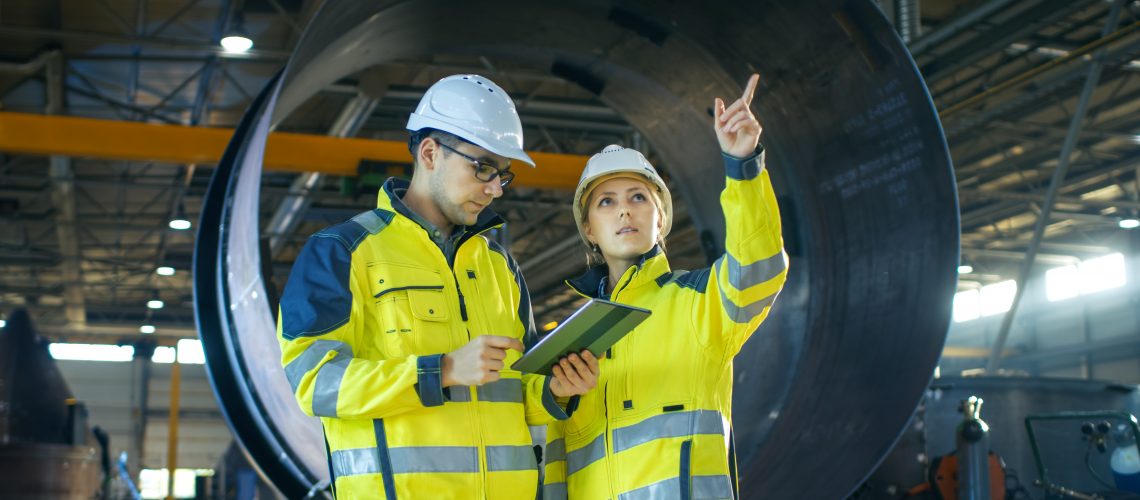
6 min read
• 22 May 2024
How to train and develop your workforce in the construction industry?
In construction industry, workforce training holds the key. Those who train & develop their employees well today will lead the construction market tomorrow.
-
eBookEmployee Upskilling - A Detailed Blueprint For Building A Skills-Driven Learning Culture
Alford Korzybski famously said, “A map is not the territory it represents.” There is something intriguing about the mismatch between the bullish forecasts and the actual ground realities in the US construction sector.
To begin with, the United States has one of the largest construction markets worldwide, with an annual expenditure of over $1,293 billion. This huge spending could significantly drive the US economy in the future.
Despite this, project after project is running behind the stipulated schedule. This shoots up construction costs by a significant margin.
How is this possible? On the one hand, experts say that the construction industry is booming, while on the other end, the market is said to be in a huge financial and time loss!
The answer lies in understanding the crux of the situation, and it’s this — there is a massive shortage of skilled labor!
In a recent survey by the U.S. Chamber of Commerce and USG Corp., 70% of construction firms said they were struggling to make deadlines because they couldn’t find enough workers.
This despite the fact that an overwhelming number of construction projects that had stalled during the recession are now back on track (in fact we are likely to see increased spending on the heavy construction segment with the Trump administration unveiling infrastructure plans valued at $1.5 trillion).
While there are other roadblocks, they all revolve around this acute labor shortage, which has a direct impact on construction costs, and along with rising material costs and land prices, makes new developments burdensome.
For instance, the construction costs increased 6.2% last year and the majority of the increase came from increased labor costs, since with labor shortages, projects take longer and bid contracts also become more expensive.
The fact is, the level of worker shortage in the construction industry is unprecedented at the moment. Moreover, the available workforce isn’t skilled enough to address the changes happening in the construction industry.
What is driving the Construction labor shortage?
There are questions we must ask:
-
Why is construction not an attractive industry to the millennials?
-
Why have the 600,000 workers who left the industry during the Great Recession not returned?
-
Should we read more into the case with the aging workforce in construction (according to JBK, about one-third of all employees in the construction industry were born after 1980, while 52% were born between 1960 and 1979)?
-
Is there a way to bring back the 2 million construction jobs that somehow disappeared during the housing downturn?
-
The pandemic fueled the fire. Most construction workers left during the lockdown and didn’t return.
If we dig deep, we will find that a lot of the fundamental worries surrounding the construction sector revolve around safety (by safety, don’t just read the personal safety on the site, but also a safe and secure career for the future).
What can we do to assuage the fears of an aspiring construction worker?
Lack of Safety in Construction Jobs
The younger job aspirants are apprehensive about going into the construction industry as it’s more prone to accidents. Every day, an average of two construction workers die due to work-related injuries in the U.S. One in five of all workplace fatalities occurring are construction-related.
According to the US Department of Labor, 769 construction worker deaths were reported to OSHA in 2017, ranging from falls to equipment failures to traffic accidents and more (the data doesn’t factor in the number of non-fatal injuries that occur on construction sites every day).
We will have to allay this fear because it is preventing new workers from entering the industry (and resulting in existing workers seeking new career paths elsewhere).
Technology to the rescue...
Bill is an aspiring construction worker. He joins a new-age company thinking that the bright future prospects of the industry will go hand in hand with his own career growth in life. Like others, he too had concerns about safety, but at the time of joining, his employer gave him a professional and effective onboarding in the form of engaging real-life simulation videos that had clear Do’s and Don’ts related to the handling of equipment. Bill was taught how to wear a helmet properly and handle the crane at steep heights. Through mobile learning, he could learn on the go. Knowledge nuggets helped him stay updated about the latest trends in the construction industry. Bill could easily learn new techniques and technology to perform efficiently. He was then subsequently assessed with a quick test to ascertain whether he understood the concepts experientially.
Bill was also given necessary training in emergency practices using interactive flashcards and engaging edutainment videos. He was made apprised of all the safety compliance features stipulated by OSHA regarding site safety. Besides, the employer gave him a clear roadmap for future growth where he could grow in his career step by step climbing up the ladder (pun intended) and building capabilities all along his path. He was explained how he could grow from a site worker to a project engineer in the next 3 years and from that to a project manager in two more years. Bill is happy. Bill can be a role model tomorrow for future construction job aspirants. Be like Bill? Anyone?
Well, at present, it all sounds too good to be true. But believe me, the Bill template is really what is missing in the Construction sector!
Where are the digital learning technologies for an aspiring millennial who wants to break new ground in construction? Where are the MOOCs for a construction worker? Where is an upskilling and capability-building platform for career acceleration?
These are not questions, but the answers to those questions that make you feel skeptical of the future.
The key to the revival of the construction industry is using smart learning technologies for day-to-day training and a better understanding of safety compliances. A complete skilling suite like Disprz can help in onboarding, upskilling, and reskilling the employee to ensure optimum performance.
When you make the workforce more knowledgeable, that eventually reflects in their everyday performance and their overall productivity goes up.
Key Areas of Employee Development in Construction
Employee development in the construction industry includes a variety of crucial areas that are critical to the success of construction projects. These include technical skills training, leadership and management training, safety and compliance training, and ongoing professional development.
Technical skills training covers diverse areas like carpentry, masonry, plumbing, and electrical work, ensuring employees excel in their roles with precision and efficiency. For instance, carpentry training instills expertise in measuring, cutting, and woodwork, vital for sturdy structures. Similarly, masonry training teaches bricklaying techniques and concrete handling for durable constructions. Plumbing training imparts knowledge on pipe installation and blueprint interpretation, enhancing efficiency.
Leadership and management training are pivotal for supervisors and managers, honing decision-making and communication skills. Effective leaders drive project success by motivating teams and resolving conflicts. These programs emphasize strategic thinking and problem-solving, vital for managing risks and resources efficiently.
Safety and compliance training prioritize workplace safety, reducing accidents through hazard identification and PPE (Personal Protective Equipment) usage. Compliance with regulations ensures a safe working environment, protecting both employees and the company's reputation.
Continuous professional development ensures employees stay updated with industry trends and technologies. Workshops, certifications, and conferences foster innovation and critical thinking, essential for overcoming construction challenges.
To summarize, employee development in construction spans technical skills, leadership, safety, and continuous learning. Investing in these areas cultivates a skilled workforce, driving project success and competitive advantage.
“A minute saved is a minute earned” — How digital training saves companies valuable time
According to McKinsey’s report "Imagining construction’s digital future", mobile training solutions for construction companies can save up to:
-
20 hours of staff per week
-
75% of the time to generate reports
-
90% of the time for information and document sharing
Don’t take these numbers lightly. These are the ways tech solutions will pretty much revolutionize the construction industry. Prioritize learning technologies over everything else; it has a direct impact on your business.
Note that at present an average field worker devotes only 30% of their working time to their direct responsibilities. The remaining 70% of their time gets lapsed in running errands like transferring materials from one place to another, cleaning up of the construction site, and searching for required equipment and machinery.
Even if 10% of this time is spent on training in areas like safety and project execution excellence, imagine the difference it would make to your business. Adopting tech for employee training is not a luxury, it’s a necessity.
When product specification has gone digital when suppliers deliver products through digital channels, when market traders are searching online software to compare prices of concrete volume, armatures, and wall blocks, when contractors are looking for the best apps to map locations and blueprints, set deadlines, and assign priority levels, what is stopping you from going digital in your employee training? You are probably late; you needed digital training solutions yesterday.
Training your workforce today to see a surge in productivity tomorrow
According to McKinsey, construction is among the least digitized industries, second only to agriculture and hunting from the bottom.
But, digitalization is not a futuristic idea. It is happening every second all across the world and there is no way to escape it. In fact Covid-19 has accelerated digitalization. Not that the construction sector is alien to it as a whole — it’s happening, though the pace is slow. Even as we write, advanced business intelligence concepts such as Big Data has already reached the construction business. Managers have started using real-time reporting tools that give them updates on the field issues, and some of them have started resolving challenges in real-time using their tablets and smartphones.
The only thing is, that employee training experiences have not yet been digitalized to that extent. None of the blue-collar workers on site will be from the Ivy League, mind you. You can’t rest on your responsibilities by giving them Google. Instead, they will need their own Google of Construction. Do you have such a comprehensive in-house repository of content exclusive to the construction business? Do you have integrations with any of the leading MOOCs that can teach construction-safe practices? Do you have in-built AI features that recommend to employees what courses they need to mandatorily learn before going on the floor? Do you have a social learning platform where construction workers can collaborate?
The above are good questions to ask if you are running one such construction business. Construction leaders have a responsibility to shift the perception of the industry and attract the next generation of young workers, promising them a bright career path where they can work and leave a mark from hire to retirement.
The construction industry is ripe for disruption. Companies that win the talent war will rule the roost in years to come. To lead the construction market tomorrow, you need to optimize your workforce today with cutting-edge training experiences.
About the author

Srinaagu Edla
Sri is a seasoned leader with a rich and diverse career spanning over a decade across IT, E-learning, L&D, and Fintech. His forte lies in consultative selling, consistently exceeding sales targets, expanding market presence across various geographies, and cultivating strategic partnerships. With a remarkable track record of launching Disprz in the USA, Europe & APAC markets, Sri is currently driving the company's growth and expansion in USA, dedicated to empowering organizations with innovative, performance-enhancing learning solutions.
More Resources
Sign up to get free resources and stay up to date with Disprz!
Discover how Disprz can align learning and upskilling with your desired business outcomes.





